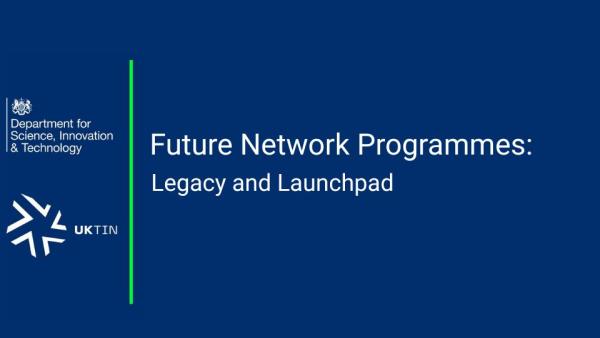Announced in 2022, the Future Open Networks Research Challenge (FONRC) is a £25 million initiative designed to enable universities, large RAN vendors, and other telecoms organisations to conduct collaborative research and development to drive the openness and interoperability of future network architectures.

UKTIN speaks to Freddy Gelati, Development Lead of the Open Networks Programme at DCMS to learn more.
1. What are the objectives of FONRC?
The challenge aims to:
- Conduct research impacting future technology roadmaps with the goal that openness and interoperability are embedded in future network architectures and systems by default.
Contribute to the strengthening of UK influence in Standards Development Organisations (SDOs). - Strengthen the UK telecoms R&D ecosystem and telecoms capability.
- Engage with DCMS, UK Research and Innovation (UKRI)/ Engineering and Physical Sciences Research Council (EPSRC,) the UK Telecoms Innovation Network (UKTIN), SONIC Labs, the UK Telecommunications Laboratory (UKTL) and other future relevant government initiatives to actively contribute to the UK’s evolving future networks and 6G vision.
It is, however, important to understand the wider context. This is about telecoms specification and pushing the agenda both nationally and internationally. The UK is a global leader in R&D and we want this open networks mission to be adopted by as many countries as possible. There are always going to be long-term challenges to address: for example, despite our best efforts, it is very likely that major players are going to continue to dominate the global market, which is why we made it a requirement that those who applied for the competition had to work with a large vendor. In the short-term, though, we can concentrate on more supplies for the UK mobile network operators and build up products and services.
2. What will the projects be working on?
There are three projects, all of which are ambitious and forward-thinking. I’m really looking forward to seeing the results.
Realising Enabling Architectures and Solutions for Open Networks (REASON) brings together an ecosystem representing the entire telecommunication R&D supply chain-including three major mobile network equipment vendors-with a mission to innovate, develop, and industrialise technologies and solutions for future 6G telecommunication networks.
REASON will develop a roadmap for open 6G network architectures, setting the framework for new developments across the entire technology stack. The project will provide novel solutions to effectively integrate multi-technology access networks and to advance their performance in line with emerging 6G key performance indicators. New concepts will be proposed to support unprecedented network densification. Smart technologies will be developed that aim to use multi-technology access networks to extract sensing information and support 6G use cases.
In addition, advanced solutions for network-edge and network-wide automation will be developed leveraging state-of-the art Artificial Intelligence (AI) techniques. REASON will provide end-to-end service optimisation through cognitive orchestration tools to enable edge-to-edge and domain-domain functionalities for a wide range of use cases.
All the required interfaces and protocols will be defined to assure interoperability of solutions. Critically, sustainability and security by design are underpinning fundamental themes that run through all architectural blocks.
TUDOR (Towards Ubiquitous 3D Open Resilient Network) is a research project aiming to solve many societal, environmental and economic grand challenges such as the digital divide and energy efficiency, by advanced technology innovations in open telecommunications systems.
Building on the UK Government’s Open RAN principles, TUDOR will research and develop open network components and their seamless interoperability in the wider RAN, core, and transport network environment and service platforms, applying them across heterogeneous networks in 5G and beyond. This will include terrestrial, airborne (e.g. High-Altitude Platform Systems – HAPS) and satellite networks, which is commonly called 3D Open Network. The plan is also to contribute to future standards (5G, 5GAdvanced and 6G), generate essential IPs and contribute to skills enhancements.
The TUDOR solutions will be tested and demonstrated showcasing both technical capabilities and interoperability.
The TUDOR consortium, led by the University of Surrey’s 5G/6G Innovation Centre (5G/6GIC), brings together world-leading researchers from UK universities, innovative equipment vendors, major network operators and network/software and system integrators from both space and terrestrial sectors. All have extensive experience in delivering collaborative research in advanced wireless and networking technologies.
YO-RAN (Yorkshire Open RAN) brings together two leading Yorkshire universities with a number of suppliers and network operators, several based in and around Yorkshire, to develop Open RAN components and a RAN Intelligent Controller (RIC) for Neutral Host Networks – another development which allows the same infrastructure to be used by multiple operators, and also by private or enterprise-based networks.
This requires in particular low-cost generic Radio Units with configurable multiband capabilities which are not currently available, and efficient fronthaul interfaces to connect them with suitable Distributed Units – all configurable via a RIC which can respond to the dynamic needs of all the network users.
3. How will FONRC tie into the wider DCMS programme?
Collaboration is crucial and something that I am particularly excited by and we are really keen in the programme to look at how all the projects and programmes we fund work together to solve the problems of the future. Many of the organisations we fund are partners in multiple projects across the programme, for example some of the FRANC programme partners are using the SONIC and UKTL facilities to test equipment developed in their FRANC projects – and that’s key to their success and will be indicative of the impact of government funding. It’s also important that the projects build broader connections and remain open minded about new partnerships and collaborations, whether that be in the form of sharing information or learning from one another.
4. Why was it important for DCMS to invest in university-led R&D?
Advanced computing technologies, including AI and Machine Learning, are taking the world by storm and driving so much innovation and growth. That’s fundamental. They are going to be a big part of future generations of telecoms technology. Thankfully, the UK has some of the best academic departments in the world doing research in these areas: we have several universities and companies in th UK now leading the world in their advanced AI capabilities, which means major telecoms companies now consider the UK a place renowned for R&Dand collaboration. FONRC brings together leading industrial innovators in this space with some of the world’s most advanced computing research departments and is set to drive major advances in this sort of innovation.
5. What will the projects’ innovations mean for the UK ecosystem?
Already, we’ve got several big companies investing in R&D in the UK and since our strategy announcement, we have had even more interest. The UK is now seen as the place to do R&D in telecoms. That’s significant. These investments will not only position us on the world stage but strengthen universities, taking research to a higher level and facilitating the exploration of adjacent technologies. Bringing together different players from a number of different sectors is critical and will only strengthen the UK’s position in the development of telecoms.









